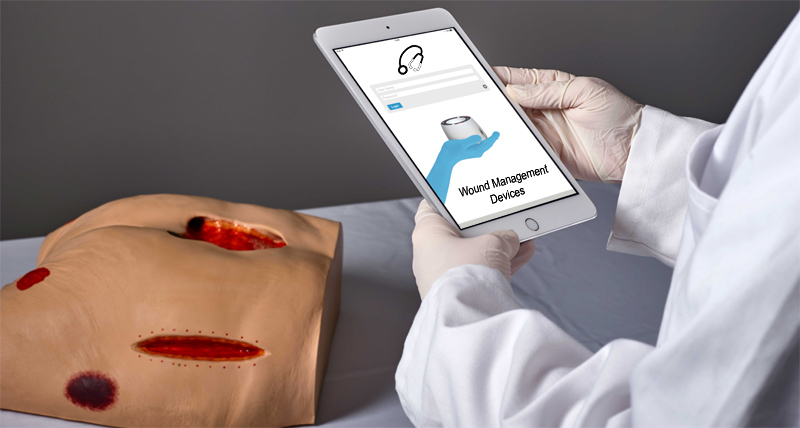Increasing Demand of Wound Management Devices Across the World
A wound happens when the skin, the largest organ of the human body, is broken because of some accident or injury. There are various types of wounds but generally, serious injuries, bleeding wounds, and infectious wounds ought to be dealt with. Management of wound and its recovery is a perplexing and cooperative process that incorporates pre-cleaning, germ treatment, wound healing, infection prevention, and treatment technique.
This cycle is typically done with the aggregate involvement of specialists, medical attendants, patients, pathologists, and wound specialists. There is no lack of wound management items in the market to treat unsafe wounds. Billions of people across the world are encountering wounds and injuries. The products that are associated with the management of the wound have been characterized to ensure high security from natural inhibitors and harmful particles. They are generally used by a specialist under the doctors’ guidelines and management. Therefore, the growing pace of cost-proficient medicine and treatment is propelling the demand for better wound management products.
Some more information about Wound Care Management
Wounds occur due to accidents, burns, injury, trauma, or natural disaster. They are generally classified into two kinds, viz. chronic and acute wounds. Chronic wounds may be created because of different kinds of maladies of life, for example, obesity, cardiovascular illnesses, and diabetes. However, acute wounds occur due to surgical or traumatic accidents. These wounds or injuries by and large get a fix through an ordinary cycle of healing at a reliable rate. Nonetheless, the amount of chronic injuries is predicted to grow in the coming years.
In the current circumstance, there are gigantic progressions in Pharmacology. A specialist like ACE restraint has helped with enhancing the limit and individual fulfillment in patients with a peripheral arterial ailment, an ordinary circulatory problem, and determinedly influenced healing of the wound. Diabetes is one of the significant wounds causing diseases. There are over 25% of diabetic individuals who are 65 years old or above. The occurrence of chronic wounds, particularly foot ulcers are developing among patients who are experiencing diabetes. These components will develop the global adoption of wound management devices in the next few years.
Role of Wound Dressing in Wound Management
There are different types of wound dressings, for instance, silver-containing hydrophilic fiber dressing, and antibacterial dressings, etc. However, based on materials, wound dressings can be arranged into foams, gauze, transparent films, alginates, composites, hydrocolloids, hydrogel. These are utilized much in wound management.
1. Composite dressings
Composite dressings are comprised of any kind of dressing materials, for instance, a mix of form and gauze, alginate and silver ion dressing, and others. There are different utilizations for this type of dressing including one-layer or two-layer dressing. Additionally, composite dressings are useful in different sorts of wounds. This sort of dressing is relatively a new type of interactive wound-cleaning dressing. In composite dressing, the external layer comprises a hydrophobic synthetic fiber material; the center part comprises polypropylene acid ester (SAP). SAP has an incredible affinity towards proteins and can effectively absorb the exudates and necrotic tissues of the injury. This sort of dressing is valuable for the debridement of rotten granulation wounds and old granulation wounds. Its advantages incorporate it is really convenient with consistent debridement, accelerating necrotic tissue exfoliation, controlling germ contaminating, and advancing the healing process of the wound.
2. Form Dressings
To make form dressings, the polymer material is used. Form dressings are frequently multi-layer structures that comprise of a wound contact layer that is anti-adhesion, infiltration layer, and waterproof and germ-resistant layer. The surface in form dressings is typically covered with a layer of the polymeric semi-permeable film. A portion of the films are self-adhesive and their major ingredient is silica gel. Its mechanism of action incorporates an absorptive form that helps in the absorption of countless exudates, diminishes infiltration, and gives a wet, warm, and closed environment for the wound healing process. The form dressings can be beneficial for the administration, treatment, and prevention of pressure ulcers, diabetic foot ulcers, skin donor region, mild burn, skin transplant, a venous ulcer, and so on. The advantage of foam dressing is that it gives a moist and closed condition for the process of healing and support autolysis debridement.
3. Gauze Dressings
Gauze dressings are made of materials that are braided or non-braided for example cotton. It comes in numerous shapes and sizes. This kind of dressing is suitable for one-time use in cleaning, hemostasis bandaging, or hygienic care of surgical or mild wounds. A gauze dressing is truly useful for wound protection, wound infection, and the management of wound exudates. By and large, for some kinds of wounds, gauze dressing can be utilized. They are effectively available at a low cost. This kind of dressing is less expensive and appropriate for different consumption levels.
Overview:
The major component fuelling the wound management market include the increasing demand for quicker recovery of wounds, increment in the number of surgeries, and the rising incidences of chronic diseases, such as diabetes. Wounds and injuries are common among individuals everywhere in the world. Expanding injuries, accidents, and wounds across the world have fuelled the development of the Wound management devices market and these variables will keep on pushing the market development in the years to come.




Comments
Post a Comment